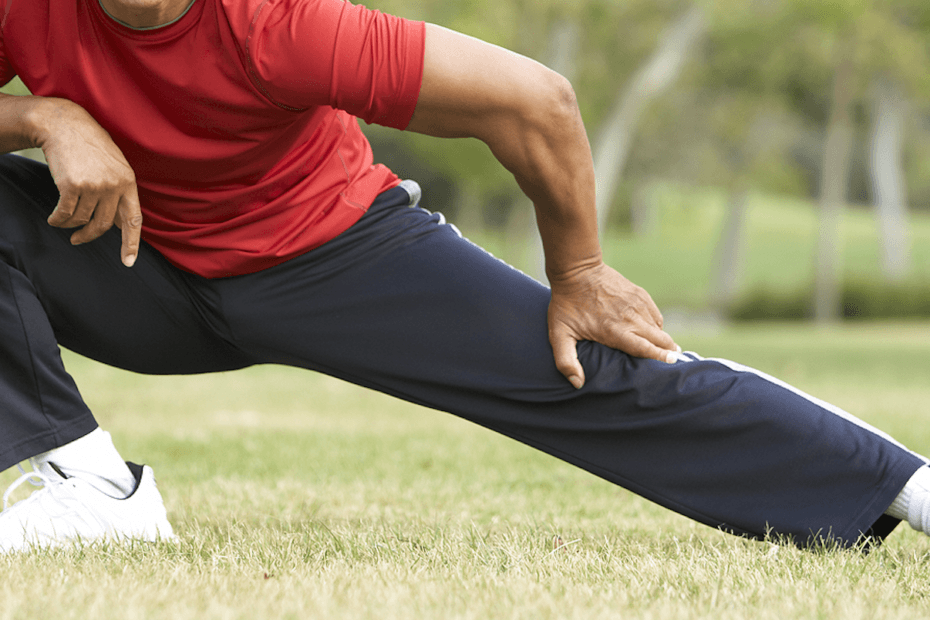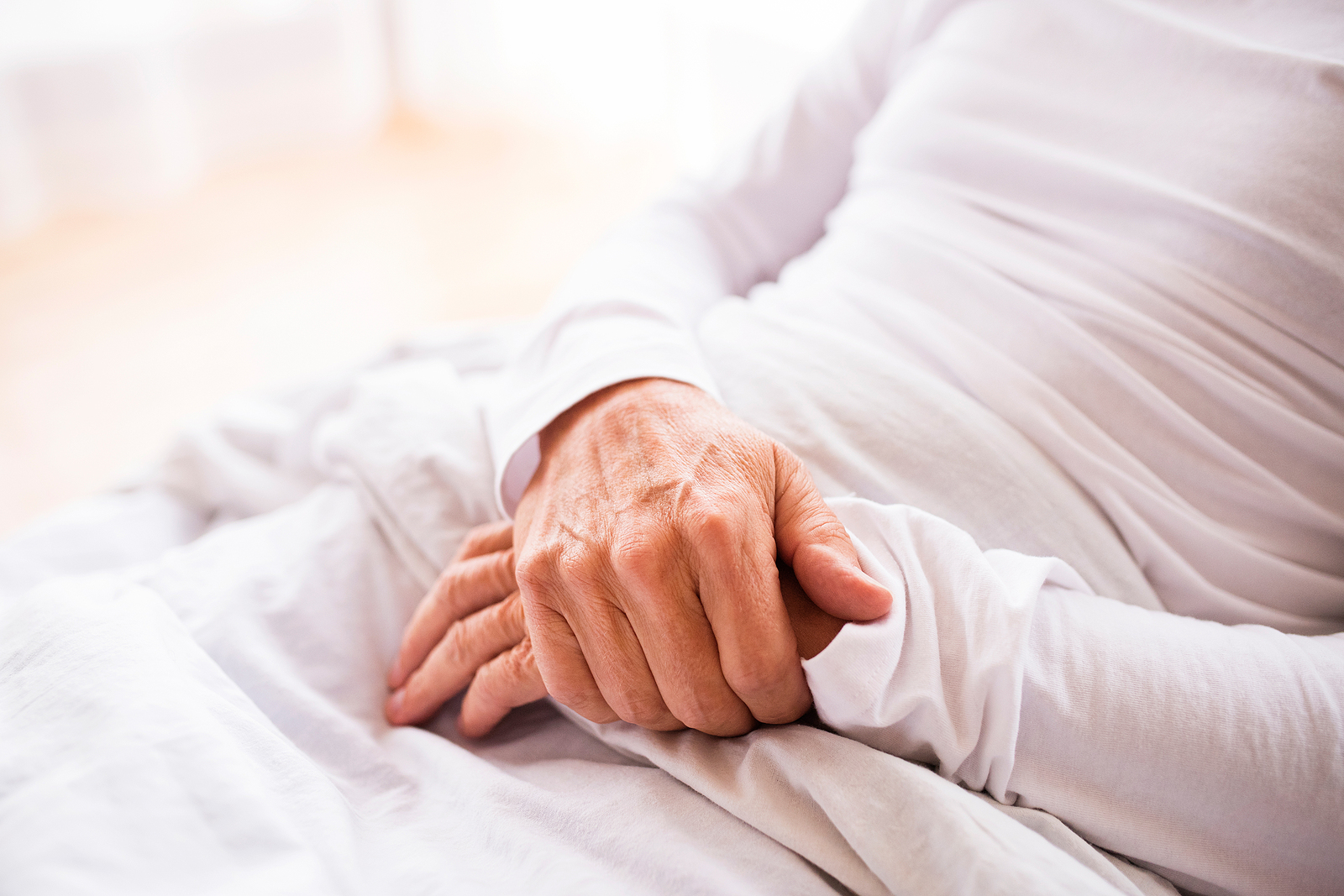Maintaining flexibility and mobility in our hips can be challenging as we age, but it’s important to try.
This is mostly because tight (and/or weak) hip muscles can lead to discomfort, difficulty with movement, and even an increased risk of falls.
Having tight muscles around your hips can also lead to back pain, which can be debilitating for seniors.
Fortunately, regular stretching can help keep your hips flexible and pain-free.
In this article, we’ll discuss some of the best hip stretches seniors can do to help maintain their mobility, as well as provide some practical tips to help you get the most from your efforts.
These exercises are designed to be gentle yet effective, but that doesn’t mean they’ll work for everyone. Please listen to your body and don’t try anything you aren’t comfortable with. When in doubt, please consult your doctor or physical therapist for guidance.
Why Hip Flexibility Is Important for Seniors
As we age, our muscles naturally lose some of their elasticity, and joints can become stiffer.
This is particularly true for the hips, which play a big role in almost every movement we make, from walking and standing to bending and sitting.
When the hips become tight or weak, it can lead to:
- Reduced Mobility: Tight hips can limit your range of motion, making everyday activities more challenging.
- Lower Back Pain: Tight hip muscles can cause compensatory movements in the lower back, leading to discomfort and pain.
- Balance Issues: Weak or inflexible hips can affect your balance, increasing the risk of falls.
- Joint Strain: Stiff hips can put extra strain on the knees and lower back, leading to joint pain and discomfort.
Incorporating regular hip stretches into your routine can help alleviate these issues, improving both your mobility and overall comfort.
Important Safety Tips Before You Start
Before starting any new stretching routine, especially if you have existing hip pain or other health concerns, keep these tips in mind:
- Warm Up: Begin with a few minutes of light activity, such as walking in place or gentle marching, to warm up your muscles.
- Start Slowly: If you’re new to stretching, start with small movements and gradually increase your range of motion.
- Listen to Your Body: Never push into a stretch that feels painful. Stretch to a point where you feel a gentle pull, not pain. You should never feel pain while stretching!
- Consult Your Doctor: If you have any pre-existing hip issues or health conditions, consult your doctor before beginning a new stretching routine.
- Hip Replacements: These exercises are not intended for seniors who’ve just had a hip replacement. After a hip replacement, you may have post-op precautions. If you’ve recently had surgery, speak to your doctor/physical therapist before trying any new exercises.
7 Best Hip Stretches for Seniors
Here are some great hip stretches that are generally safe and pretty easy to perform for seniors. And as always, feel free to adjust the reps/hold times to meet your needs.
Single Knee to Chest
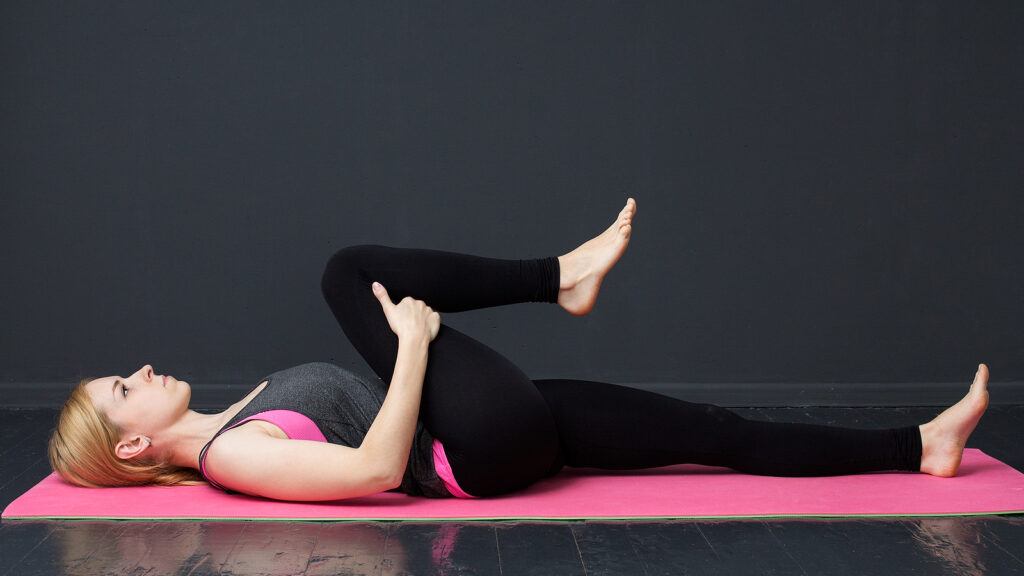
If your hips are really tight and you’re not sure what you can handle, this exercise is a great place to start.
It gently gives you a stretch in your glute muscles and the fact that you can do it while lying comfortably in bed always helps.
- From a lying position, bend one knee up toward your chest
- Grab above or below that knee and gently pull toward your chest as you feel a stretch in the back of your hip
- Hold for 20-30 seconds, switch to the other leg
- Repeat 3-4x for each side
FYI, is a great lower back stretch for seniors as well.
Lying Piriformis Stretch
The piriformis is a relatively small muscle located in the back of your hip, but it can play a big role in contributing to hip and leg pain (sciatica is often caused by a tight piriformis).
It’s also tight on most seniors, so even if you aren’t experiencing posterior hip pain, it’s a good idea to stretch this muscle out.
- From a lying position, bend one knee up and over toward your opposite shoulder
- Grab the outside of your knee and apply gentle pressure
- You should feel the stretch in the back of your hip
- Hold for 20-30 seconds and switch sides
- Repeat 3-4x for each side
Some seniors may feel a little pinch in the front of the hip being stretched – if this happens, try adjusting the angle of your stretch. If it continues, try the figure-4 stretch below instead.
Lying Figure-4 Stretch
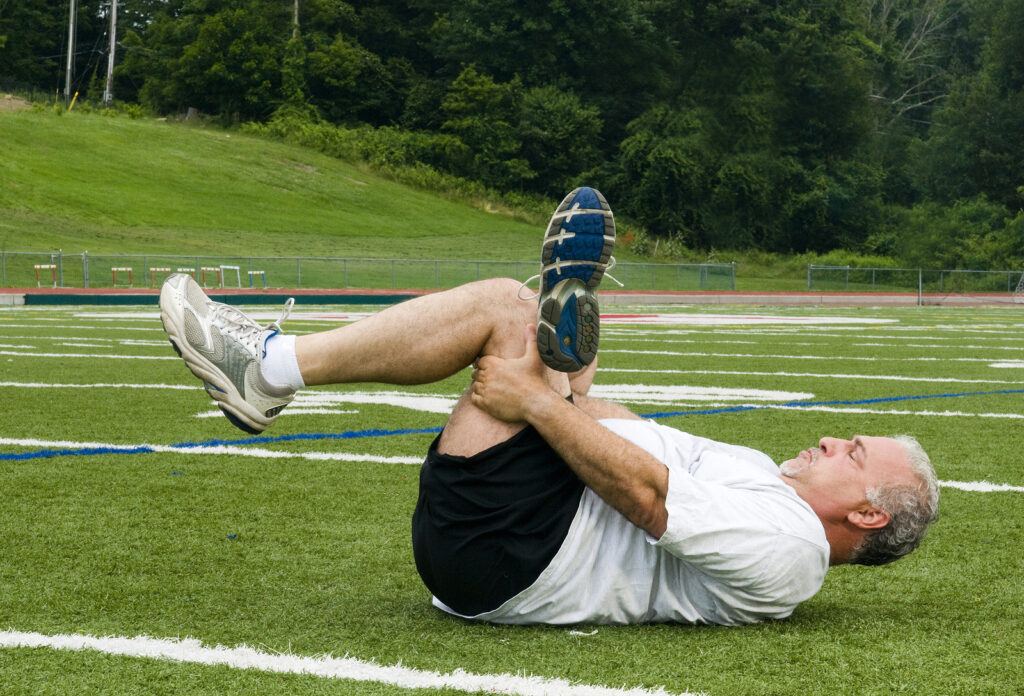
This is another good stretch for your piriformis (as well as other glute muscles) and like the exercise just mentioned, you can also do it from the comfort of your bed.
- From a lying position, bend one knee up, keeping that foot planted on the bed
- Bring your opposite leg up and cross that foot over the bent knee, creating a figure-4
- Gently slide the planted foot closer to your body until you feel a stretch in the back of the crossed leg’s hip
- Hold for 20-30 seconds and then switch sides
- Repeat 3-4x for each hip
Some seniors might feel a stretch by simply bringing their foot up over their knee, others may have to actually bring their planted knee up toward their chest.
Lying Hip External Rotation
This is a gentle stretch that can help loosen up the muscles in your inner thighs (muscles that we often neglect).
Improving this movement can also make things like getting in/out of cars and getting in/out of bed easier.
- From a lying position, bend both knees up while keeping your feet on the bed
- While keeping your knees bent, rotate one leg so the knee is going down toward the bed
- You should feel a gentle stretch in your groin
- Hold for 20-30 seconds and then switch to the other side
- Repeat 3-4x for each leg
This is basically the single leg version of the “butterfly stretch”, if you remember that one from PE class.
Seated Figure-4 Stretch
This is the seated version of the exercise mentioned earlier and it’s a great alternative for seniors who may have a hard time holding the position while on their back.
- From a seated position, bring one leg up as if you were crossing your legs and place that ankle on the opposite knee
- While maintaining a good upright posture, apply gentle overpressure to your bent knee
- You should feel a stretch in the back of the crossed leg’s hip
- Hold for 20-30 seconds and then switch sides
- Repeat 3-4x for each leg
For additional stretch, you can start leaning forward, but make sure you’re leaning from the hips and not rounding your back.
Standing Hip Flexor Stretch
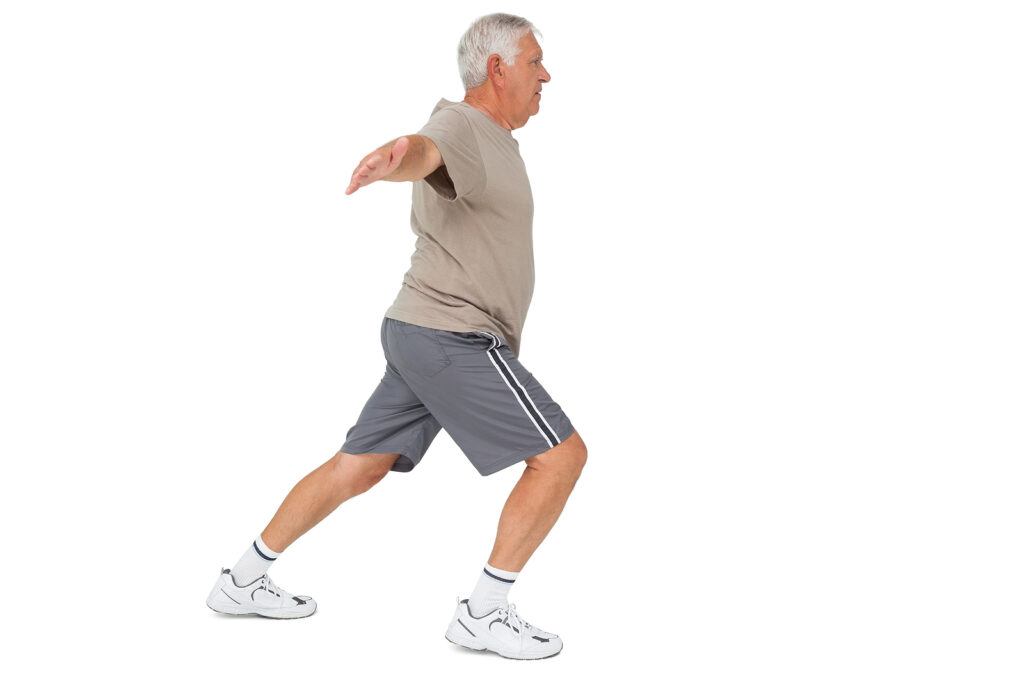
This standing stretch is a great way to stretch the front of the hips and thighs, but I want to make sure you’re careful while trying.
If your balance is off or you have significant hip/back pain, this one might be challenging – and the last thing we want is an injury or fall while trying to stretch.
- Stand with one foot forward and the other foot back, as if in a lunge position
- Keep your back leg straight and your front knee bent
- Gently push your hips forward, feeling a stretch along the front of your hip and thigh
- Hold the position for 20-30 seconds and then switch sides
- Repeat 3-4x for each leg
This stretch helps to relieve tightness in the hip flexors, which can contribute to lower back pain and hip discomfort.
Helpful tip: perform this stretch along side the kitchen counter, it gives you a great place to hold on for balance.
Standing Hip Abduction Stretch
This standing exercise is a great way to stretch your adductors, the muscles along your inner thigh, which are often forgotten.
Like the hip flexor stretch just mentioned, you have to be careful with this one, especially if you’re currently experiencing hip pain.
- Start from a standing position with your legs spread wide apart
- Keeping one knee straight, bend your opposite knee as you lunge toward that side (you should feel a stretch in the inner thigh of the straight leg)
- Hold for 20-30 seconds and then return to the starting position
- Switch sides and repeat on the other leg
- Repeat 3-4x for each leg
This exercise is similar to the standing hip flexor stretch, you’re just changing the orientation of your pelvis.
Incorporating These Stretches Into Your Routine
For the best results, try to incorporate these hip stretches into your daily routine.
That doesn’t mean doing all of them everyday though.
The stretches each senior would benefit the most from depends largely on what areas are the tightest, but generally speaking, I’d pick 3-4 of these exercises and try to do them 1-2x/day.
Feel free to mix and match to see which stretches give you the best results and don’t be afraid to switch things up regularly.
If you’re anything like me, you get bored easily doing the same exercises day in and day out.
The best practice when trying to improve flexibility would be to do your stretches once in the morning and then again in the evening.
But I’m a realistic guy and realize a lot of us aren’t going to stretch 2x/day.
So just do what you can.
But again, you have to stretch regularly to improve your flexibility.
When to Seek Medical Advice
While stretching is beneficial for most people, it’s important to seek medical advice if you experience persistent or severe hip pain, or if stretching causes discomfort.
A healthcare professional can provide personalized guidance and ensure you’re stretching safely.
And I want to say this again – you should not feel pain while performing any of these stretches; if you do, please stop.
Pain is not a normal part of stretching.
Final Thoughts
Ok, I think that about does it.
Maintaining hip flexibility is a good idea as we age because it can help prevent things from getting overly tight and turning into problems.
Stretching regularly can help maintain joint range of motion as well as prevent hip and back pain from occurring.
All of which helps seniors stay comfortable and independent for as long as possible.
Anyway, I hope you found this article helpful, but if you have any questions or concerns about these (or other) stretches, feel free to reach out.
You can email me or leave a comment below and I’ll get back to you shortly.
